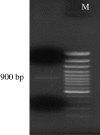Molecular Identification and Sequencing of Mannose Binding Protein (MBP) Gene of Acanthamoeba palestinensis
- PMID: 22347229
- PMCID: PMC3279820
Molecular Identification and Sequencing of Mannose Binding Protein (MBP) Gene of Acanthamoeba palestinensis
Abstract
Background: Acanthamoeba keratitis develops by pathogenic Acanthamoeba such as A. palestinensis. Indeed this species is one of the known causative agents of amoebic keratitis in Iran. Mannose Binding Protein (MBP) is the main pathogenicity factors for developing this sight threatening disease. We aimed to characterize MBP gene in pathogenic Acanthamoeba isolates such as A. palestinensis.
Methods: This experimental research was performed in the School of Public Health, Tehran University of Medical Sciences, Tehran, Iran during 2007-2008. A. palestinensis was grown on 2% non-nutrient agar overlaid with Escherichia coli. DNA extraction was performed using phenol-chloroform method. PCR reaction and amplification were done using specific primer pairs of MBP. The amplified fragment were purified and sequenced. Finally, the obtained fragment was deposited in the gene data bank.
Results: A 900 bp PCR-product was recovered after PCR reaction. Sequence analysis of the purified PCR product revealed a gene with 943 nucleotides. Homology analysis of the obtained sequence showed 81% similarity with the available MBP gene in the gene data bank. The fragment was deposited in the gene data bank under accession number EU678895,
Conclusion: MBP is known as the most important factor in Acanthamoeba pathogenesis cascade. Therefore, characterization of this gene can aid in developing better therapeutic agents and even immunization of high-risk people.
Keywords: Acanthamoeba palestinensis; Mannose Binding Protein (MBP); PCR.
Figures
Similar articles
-
Current Status of Acanthamoeba in Iran: A Narrative Review Article.Iran J Parasitol. 2015 Apr-Jun;10(2):157-63. Iran J Parasitol. 2015. PMID: 26246812 Free PMC article. Review.
-
The gene expression and proteomic profiling of Acanthamoeba isolates.Exp Parasitol. 2023 Dec;255:108630. doi: 10.1016/j.exppara.2023.108630. Epub 2023 Oct 21. Exp Parasitol. 2023. PMID: 37820893
-
Genotyping of Acanthamoeba spp. and characterization of the prevalent T4 type along with T10 and unassigned genotypes from amoebic keratitis patients in India.J Med Microbiol. 2016 May;65(5):370-376. doi: 10.1099/jmm.0.000234. Epub 2016 Feb 16. J Med Microbiol. 2016. PMID: 26887324
-
Genotypic, physiological, and biochemical characterization of potentially pathogenic Acanthamoeba isolated from the environment in Cairo, Egypt.Parasitol Res. 2016 May;115(5):1871-81. doi: 10.1007/s00436-016-4927-3. Epub 2016 Feb 3. Parasitol Res. 2016. PMID: 26841771
-
Acanthamoeba keratitis: an emerging disease gathering importance worldwide?Trends Parasitol. 2013 Apr;29(4):181-7. doi: 10.1016/j.pt.2013.01.006. Epub 2013 Feb 21. Trends Parasitol. 2013. PMID: 23433689 Review.
Cited by
-
Repertoire of free-living protozoa in contact lens solutions.BMC Ophthalmol. 2016 Oct 29;16(1):191. doi: 10.1186/s12886-016-0370-6. BMC Ophthalmol. 2016. PMID: 27793130 Free PMC article.
-
Isolation and Genotyping of Acanthamoeba spp. as Neglected Parasites in North of Iran.Korean J Parasitol. 2016 Aug;54(4):447-53. doi: 10.3347/kjp.2016.54.4.447. Epub 2016 Aug 31. Korean J Parasitol. 2016. PMID: 27658596 Free PMC article.
-
Acanthamoeba Mannose and Laminin Binding Proteins Variation across Species and Genotypes.Microorganisms. 2022 Oct 31;10(11):2162. doi: 10.3390/microorganisms10112162. Microorganisms. 2022. PMID: 36363753 Free PMC article.
-
Acanthamoeba-mediated cytopathic effect correlates with MBP and AhLBP mRNA expression.Parasit Vectors. 2017 Dec 28;10(1):625. doi: 10.1186/s13071-017-2547-0. Parasit Vectors. 2017. PMID: 29282148 Free PMC article.
-
Current Status of Acanthamoeba in Iran: A Narrative Review Article.Iran J Parasitol. 2015 Apr-Jun;10(2):157-63. Iran J Parasitol. 2015. PMID: 26246812 Free PMC article. Review.
References
-
- Khan NA. Pathogenesis of Acanthamoeba infections. Microb pathogen. 2003;34:277–285. - PubMed
-
- Khan NA. Acanthamoeba: biology and increasing importance in human health. FEMS Microbiol Rev. 2006;30:564–595. - PubMed
-
- Visvesvara GS, Moura H, Schuster FL. Pathogenic and opportunistic free-living amoebae: Acanthamoeba spp., Balamuthia mandrillaris, Naegleria fowleri, and Sappinia diploidea . FEMS Immunol Med Microbiol. 2007;50:1–26. - PubMed
-
- Niyyati M, Lorenzo-Morales J, Rezaie S, Rahimi F, Mohebali M, Maghsood AH, Motevalli-Haghi A, Martín-Navarro CM, Farnia S, Valladares B, Rezaeian M. Genotyping of Acantha-moeba isolates from clinical and environmental specimens in Iran. Exp Parasitol. 2009;121(3):242–5. - PubMed
LinkOut - more resources
Full Text Sources
Miscellaneous

